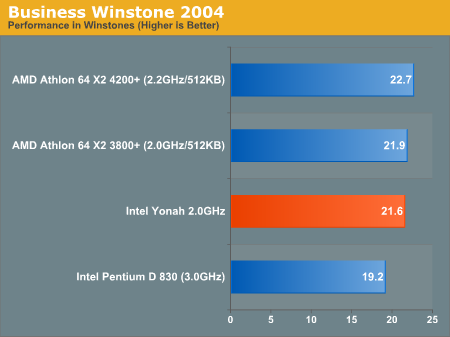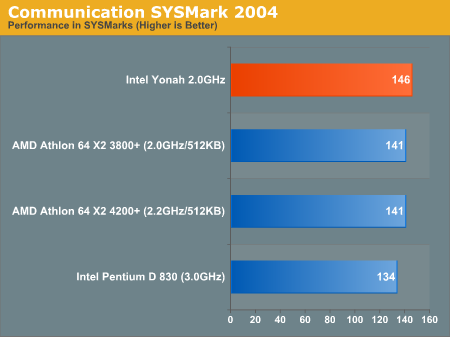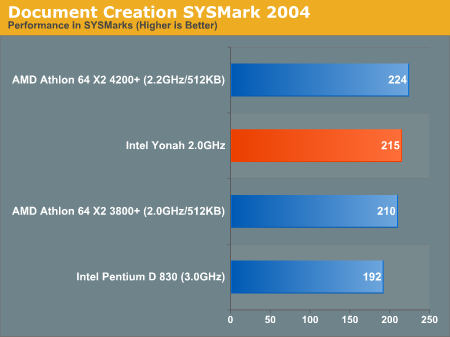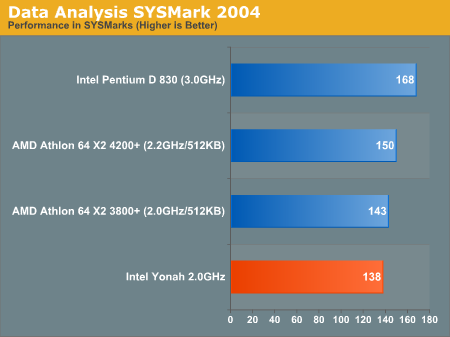Intel Yonah Performance Preview - Part I: The Exclusive First Look at Yonah
by Anand Lal Shimpi on November 30, 2005 2:50 AM EST- Posted in
- CPUs
The Test
Our test configuration is identical to what we used in our Athlon 64 X2 3800+ review, however we can’t disclose the motherboard used for the Yonah platform. We can say that it used the Intel 945G chipset and was outfitted with 2 x 512MB DDR2-533 DIMMs; the rest of the configuration remained the same as the AMD and Intel systems.
Once again, keep in mind that the platform and processor are pre-release samples, and performance could change by the time the parts head to retail. This is nothing more than a preview, so treat it as such.
Business Winstone 2004
Business Winstone 2004 tests the following applications in various usage scenarios:
. Microsoft Access 2002
. Microsoft Excel 2002
. Microsoft FrontPage 2002
. Microsoft Outlook 2002
. Microsoft PowerPoint 2002
. Microsoft Project 2002
. Microsoft Word 2002
. Norton AntiVirus Professional Edition 2003
. WinZip 8.1

Just as we saw in the Dothan vs. Yonah tests, Yonah loses some of its competitive edge in the Business Winstone benchmark. Although in this case, it's not very far off the Athlon 64 X2 3800+.
Office Productivity SYSMark 2004
SYSMark's Office Productivity suite consists of three tests, the first of which is the Communication test. The Communication test consists of the following:
"The user receives an email in Outlook 2002 that contains a collection of documents in a zip file. The user reviews his email and updates his calendar while VirusScan 7.0 scans the system. The corporate web site is viewed in Internet Explorer 6.0. Finally, Internet Explorer is used to look at samples of the web pages and documents created during the scenario."

Yonah manages to be quite competitive in the SYSMark tests, slightly outpacing the Athlon 64 X2 4200+ here.
The next test is Document Creation performance, which shows very little difference in drive performance between the contenders:
"The user edits the document using Word 2002. He transcribes an audio file into a document using Dragon NaturallySpeaking 6. Once the document has all the necessary pieces in place, the user changes it into a portable format for easy and secure distribution using Acrobat 5.0.5. The user creates a marketing presentation in PowerPoint 2002 and adds elements to a slide show template."

Here we see that at 2.0GHz, Intel's Yonah is right in the middle of AMD's Athlon 64 X2 4200+ and the X2 3800+. Given that the CPU has no on-die memory controller, yet performs comparably to an identically clocked Athlon 64 X2, it's not a bad position to be in for Yonah.
The final test in our Office Productivity suite is Data Analysis, which BAPCo describes as:
"The user opens a database using Access 2002 and runs some queries. A collection of documents are archived using WinZip 8.1. The queries' results are imported into a spreadsheet using Excel 2002 and are used to generate graphical charts."

The Data Analysis test is dominated by the Pentium D, but even the Athlon 64 X2 3800+ holds a slight advantage over the 2.0GHz Yonah.










135 Comments
View All Comments
fitten - Wednesday, November 30, 2005 - link
[quote]Sigh...have you ever heard of Google before? It's a wonderful little search engine that would have shown you inumerable articles on the Dual Core Turion being released in early 2006... [/quote]"Early" 2006 is indeed the quote from the ones I saw.
[quote]Gee...then increasing their marketshare by 75% from Q2 to Q3 was unsuccessful, eh? [/quote]
Well... so 1.75X is interesting... without knowing what X is, we cannot draw any conclusions from your statement. If AMD sold 4 laptops in Q2, a 75% increase would be 7 laptops for Q3. Selling 7 laptops is not exciting and is miniscule marketshare. Intel's Centrino/Sonoma/etc. laptop packaging schemes are really nice for manufacturors and has been very popular, even increasing the entire laptop market's numbers. Intel has a huge share of the laptop market right now, even larger than the desktop market.
[quote]quote:
--------------------------------------------------------------------------------
Turion power consumption isnt quite on the same level as Dothan. They will need to move to 65nm before building Turion laptops
--------------------------------------------------------------------------------
If someone could translate this for me, I'd be happy to respond... [/quote]
Seems like English to me. What language do you need it translated into? The one obvious issue was one the author corrected himself. He meant to say "dual-core Turion laptops" instead of what he directly said. Just a simple restatement may make it clear: Dothan power consumption is less (which is better) than Turion and Yonah is on par with Dothan or better than Dothan. AMD will need to have 65nm dual core Turions to be/remain competitive with Yonah parts. I don't think much response is necessary since the statement is pretty much accurate. Laptops are about battery life and small form factor. Intel is winning there, no question about it.
Personally, I have 8 machines at home including laptops. The two laptops are both Banias/Dothan based but all my desktops are AMD. Three are Athlon64s and the rest are AthlonXPs. I'm not a fanboi. I simply by what I think are the best tools for the job. I think AMD desktop CPUs are better than Intel offerings. I think Intel laptops are better than AMD offerings. However, I'd love to get an Athlon64 laptop so I could run a 64-bit OS on a laptop for my development but I rarely use the laptop that I have these days so getting another doesn't make sense right now. Don't let religion cloud your senses. I know it's easy to do.
Viditor - Wednesday, November 30, 2005 - link
A fair enough comment...I shall expand.
Firstly, AMD released the Turion late. The problem is that OEMs that manufacture laptops always release their new designs near January, and AMD didn't get them the Turion in time for a 2005 release. That said, all major OEMs except Dell have already stated that they will be releasing numerous Turion laptops next year...
Secondly, Turion sales last quarter represented the largest number of mobile processors that AMD has ever sold. Don't get me wrong, Intel sells one helluva lot more right now...but when AMD is able to achieve design wins with laptop OEMs next year, that's expected to start to even up...
Yes, I know...unfortunately he corrected himself while I was typing my reply...
I certainly DO question it...take a look at the http://www.laptoplogic.com/resources/detail.php?id...">Laptop Logic review...
Notice to what extent they've documented all of their testing and retesting...
It shows Turion and Dothan are at about the same power usage. Unfortunately, Anand didn't have (I assume) a Turion to compare against for this review...
I think many people need to reevaluate their assumptions about the P-Ms supremacy in power usage.
One other thing to keep in mind is that the Turion is 64bit and the Dothan/Yonah are not. Remember that 64bit adds to power usage, so we still aren't comparing apples to apples yet...
tayhimself - Wednesday, November 30, 2005 - link
I dont want to bother rehashing everything addressed in fittens well written reply above, but I'll add a few things.AMD is nearly 50% of PC desktops sold at retail (this excludes laptops, dell and corporate), but the laptop market has recently become bigger than the desktop. intel has nearly 80% of the overall market. Excluding dell home sales, it still stands that intel has a large lead in the corporate and laptop areas (they probably overlap a lot). So if AMDs laptop market share is 75% bigger, they still have a long way to go. The opteron, and to a lesser extent, the A64 have been so much BETTER than intel and yet AMD has only recently made inroads into the server market and expanded their desktop market share to near where it was in the AthlonXPs heyday.
They disabled enhanced speedstep? What does the powermanagement software do other than put the CPU in different modes? Still the numbers on the Turions are in the same region that I would'nt hesitate (too much) picking a Turion for myself or a friend. I'd still choose the intel if the price was the same though (for the fantastic chipset not the cpu). All that said, the 25W Turions are worthy laptop cpus, and I'm hoping for a successful Turionx2 so that we can have dual core everywhere sooner rather than later.
WRT dual core Turions on 130 nm, I dont think too many people will find them interesting other than for the 7-9 lb DTR "laptops".
Viditor - Thursday, December 1, 2005 - link
Turions have never been 130nm...you meant 90nm. The dual core Turions will be 90nm, and will migrate to 65nm mid year...
Darth Farter - Wednesday, November 30, 2005 - link
and again are people ignoring the fact that DDR2 is giving the P-M an edge in battery life....IntelUser2000 - Friday, December 2, 2005 - link
It showed in an -->INTEL<-- presentation that showed that DDR2-533 consumes SAME POWER as DDR400!!! Yonah uses DDR2-667, and WILL consume more power than DDR400.So when AMD goes DDR2, there will be a relative disadvantage in power consumption.
IntelUser2000 - Friday, December 2, 2005 - link
Even if DDR2 is 50% low power than DDR400, that's assuming they are at same clock.DDR2-667 would be close to DDR400 in power consumption so Yonah has no real advantage in RAM power consumption UNLIKE THE CONTRARY.
Gary Key - Wednesday, November 30, 2005 - link
Let's not forget the fact that the memory controller is on the North Bridge of the Intel system so you have it and a South Bridge to power unlike a single chip solution in the AMD systems. This is one reason why we look at total system power usage instead on concentrating on one particular component as it provides a look at the platform differences in a fair manner. Also, not all DDR-2 runs at 1.8v, several suppliers provide 2~2.1v modules depending upon the latencies requested by the OEM.Shintai - Wednesday, November 30, 2005 - link
The Northbridge for a centrino chipset with GFX is between 3.0-3.5W peak.Darth Farter - Wednesday, November 30, 2005 - link
-----------------------------------------------------"Let's not forget the fact that the memory controller is on the North Bridge of the Intel system so you have it and a South Bridge to power unlike a single chip solution in the AMD systems."
-----------------------------------------------------
hey, AMD: ATi, VIA, SIS and even the NForce4 Sli(the one with 2x 16pci-e lanes editions) all use a southbridge too, plz investigate before making such claims...
and that gives the yonah/pentium-m otherwise the advantage everyone touts over the net in power usage as AMD has it's included on chip which makes the AMD chip use more.
Also, the Pentium-M/yonah have 2x the cache which is back to AMD's advantage..........
-----------------------------------------------------
"This is one reason why we look at total system power usage instead on concentrating on one particular component as it provides a look at the platform differences in a fair manner. "
-----------------------------------------------------
excluding what I just said about DDR vs DDR2 with the obvious advantages you seem to avoid....
and:
"...instead of concentrating on..." uh, we're looking at yonah vs manchester here (which ARE particular components)?
-----------------------------------------------------
"Also, not all DDR-2 runs at 1.8v, several suppliers provide 2~2.1v modules depending upon the latencies requested by the OEM"
-----------------------------------------------------
as does ddr2 requiring often 3+ in volts making your arguement completely reversed in DDR's heavy disadvantage...
BTW, I looked it up before posting but couldn't find any evidence, but it seems OCZ EL PC3200 rus at 2-3-2 timings stock and requires 2.75Vdimm to function at 2-2-2-1T @ DDR400.... but as I wasn't sure I let this out of my statements....
anyway not really a point here in battling chip architecture as it's just trading blows, but my point being platform difference is mainly the DDR2 vs DDR1 with a TANGIBLE difference in power consumption between the two which is discredited incorrectly imo to the CPU's power consumption on the last page.... see?